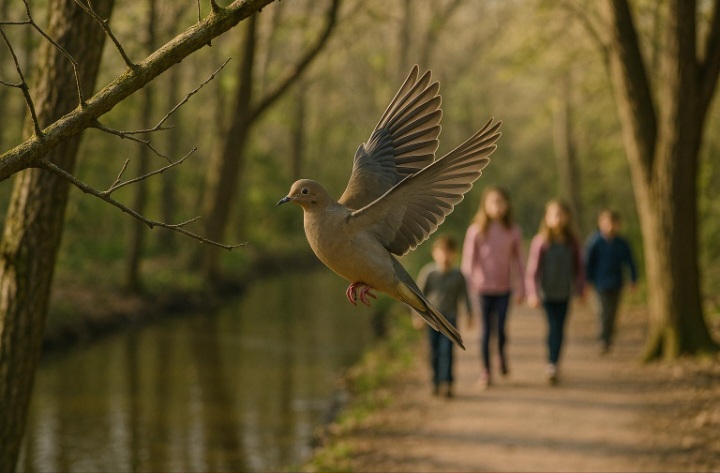There was once a small mourning dove who loved to perch on a slender branch just above a quiet forest path. The branch gave her a view of the path below, where people strolled each day—some briskly, some aimlessly, some lost in thought.
At first, the bird delighted in the scene. But over time, she began to wonder: Do they see me? Do they think my feathers are dull? Is my song forgettable? So she perched a little stiffer, holding her breath whenever someone passed by, trying to strike the perfect pose. The branch became less of a resting place and more of a stage.
Still, the branch didn’t break. It stayed steady. But the bird began to feel tired. She realized she was holding herself up with tension, not trust. She wasn’t really resting—she was performing.
One morning, she tried something new. Just for a moment, she fluttered off the branch and landed softly in the dewy grass below. It was quiet there. No stage. Just the tickle of grass on her feet, the warmth of the sun on her wings, the rhythm of her own breath.
She smiled to herself. This, she thought, is presence.
This, she realized, is peace.
She didn’t abandon the branch. She still perched there sometimes. But now, she took breaks—intentional, mindful pauses. She remembered her wings. She remembered the ground. And from that gentle rhythm of flight and landing, presence and perspective, she found something deeper than safety: she found herself.
Resting Without Breaking: A Reflection on Perception, Mindfulness, and Grace
Many of us live like that dove—perched on the unsteady branch of other people’s imagined opinions. We freeze into performance, contorting ourselves into someone else's ideal, even when no one is really watching. The branch may hold, but we become fragile.
This is what social psychologist Charles Horton Cooley described as the looking-glass self—the idea that we shape who we are based on how we think others perceive us. But these perceptions are rarely accurate. As psychology researchers Thomas Gilovich and Victoria Medvec have shown in their work on the spotlight effect, we consistently overestimate how much other people notice and remember about us.
So what keeps us stuck? Anxiety. The belief that if we can predict and control how others see us, we’ll feel safe. But ironically, the more tightly we grip that branch, the less we trust ourselves to move. To live.
Mindfulness offers an antidote. It doesn’t require us to abandon the branch or reject our desire to be seen. It simply invites us to take gentle pauses—to remember that we can land, breathe, and be okay without constant validation.
As Jon Kabat-Zinn, the founder of Mindfulness-Based Stress Reduction (MBSR), explains, mindfulness is “paying attention in a particular way: on purpose, in the present moment, and nonjudgmentally.” It’s not about avoiding discomfort—it’s about meeting our experience with curiosity instead of critique.
And over time, as we practice resting in the moment rather than in imagined perceptions, we strengthen our inner steadiness. We grow less reactive. More compassionate. We develop what Buddhist philosophy calls upekkha—a kind of balanced detachment. Not withdrawal, but clarity. Not coldness, but peace.
As Pema Chödrön writes, “You are the sky. Everything else—it’s just the weather.”
Grace as a Daily Practice
Letting go of imagined judgments creates space for grace—both for ourselves and others. We realize that we, too, often misperceive people. That our internal stories about them might be just as off as the ones we think they tell about us.
This softens us.
According to Kristin Neff, a pioneer in the field of self-compassion, one of the keys to emotional resilience is recognizing our shared humanity. “Self-compassion,” she writes, “involves treating yourself the way you would treat a friend who is having a hard time.” When we do that, we stop requiring perfection and start allowing ourselves to be fully human.
Grace means we don’t need to prove anything. We can just be—perching when it feels right, flying when we’re ready, landing gently when we need rest.
The Path Beneath the Branch
There will always be people walking by—some noticing, some not. Some judging, some not. But they’re not the point.
What matters is that we remember we are not just the bird.
We are the wings.
We are the rhythm of breath and return.
We are the pause that saves us from exhaustion.
So the next time you feel yourself gripping too tightly—worried about being seen, misunderstood, or judged—remember the mourning dove. She didn’t need the branch to break to remember she could fly.
She just needed to trust herself enough to land.
Keywords:
• mindfulness and self-perception
• detachment from external validation
• the spotlight effect in psychology
• self-compassion and emotional growth
• Jon Kabat-Zinn mindfulness
• Pema Chödrön detachment quote
• Kristin Neff self-compassion
• mindfulness for anxiety
• letting go of judgment
• how to stop worrying what others think
ChatGPT & Paul Tupciauskas
|
|

